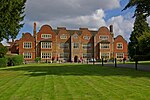Dorking West railway station
1849 establishments in EnglandDorkingFormer South Eastern Railway (UK) stationsPages with no open date in Infobox stationRailway stations in Great Britain opened in 1849 ... and 2 more
Railway stations in SurreyRailway stations served by Great Western Railway

Dorking West railway station is in Dorking, Surrey, England. It is 30 miles 42 chains (30.53 miles, 49.13 km) measured from London Charing Cross via Redhill and is one of three stations serving the town (the others are Dorking and Dorking Deepdene). Dorking West is on the North Downs Line. The station is managed by Great Western Railway, which also operates all trains serving it. The station is unstaffed, and there is no ticket office at the station, nor have ticket machines been installed. Passengers travelling from the station must purchase tickets on board the train.
Excerpt from the Wikipedia article Dorking West railway station (License: CC BY-SA 3.0, Authors, Images).Dorking West railway station
Old Char Wharf, Mole Valley
Geographical coordinates (GPS) Address Nearby Places Show on map
Geographical coordinates (GPS)
| Latitude | Longitude |
|---|---|
| N 51.236 ° | E -0.34 ° |
Address
Old Char Wharf
Old Char Wharf
RH4 1HF Mole Valley
England, United Kingdom
Open on Google Maps








